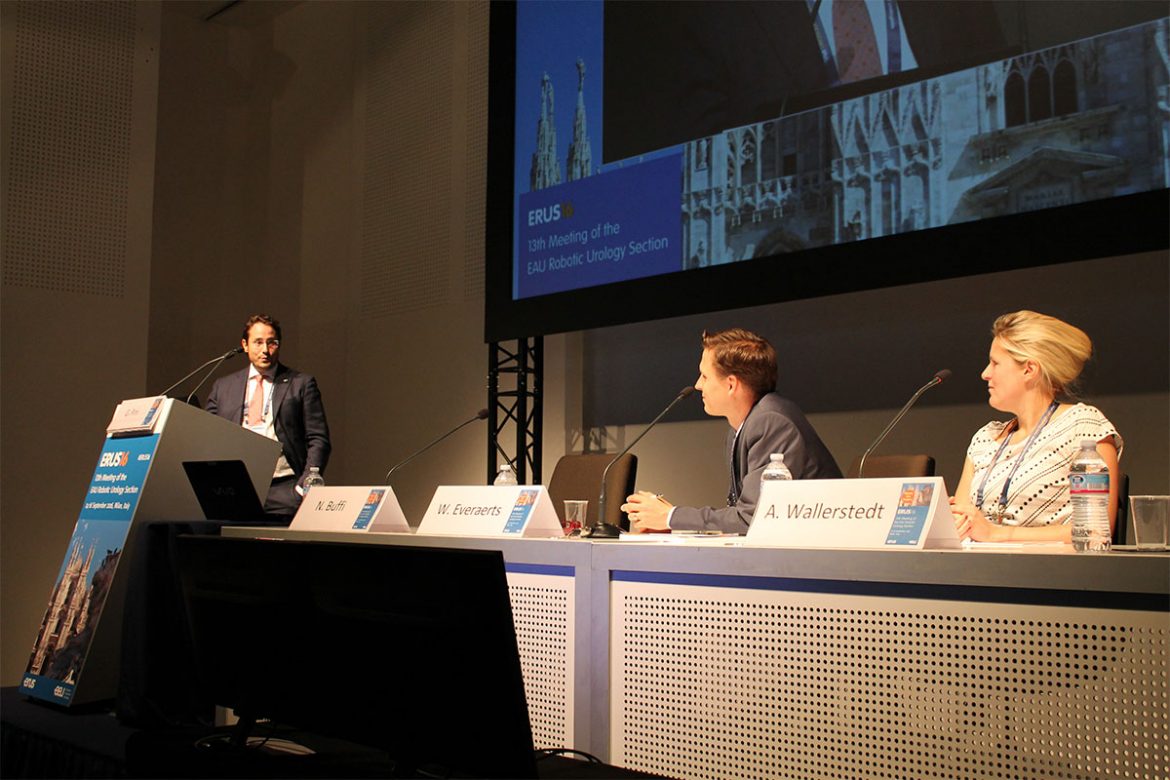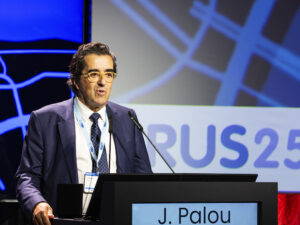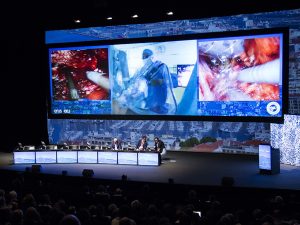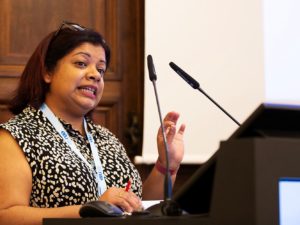ERUS16 kicked off with a special four-hour programme, intended to offer beginning urologists the relevant information to help them in their careers. For the first time in the six years, the Junior ERUS – Young Academic Urologists’ Meeting included a segment of live surgery. The eighty delegates were treated to a robot-assisted radical prostatectomy with dual console, as performed by Dr. Nicolas Doumerc, and assisted by Dr. Bernardo Rocco.
Nicolomaria Buffi, Chairman of the Young Academic Urologists, and also chairing the joint meeting explained the choice of procedure for this relatively young audience: “This is a very common procedure. Every urologist starts out by working on the prostate before moving on to the kidneys and other more specific procedures. At the same time, this is a demonstration of the dual console, a very useful tool for tutoring and reducing mistakes.”
ERUS16, the 13th Meeting of the EAU Robotic Urology Section is taking place in Milan on 14-16 September.
A look into the future of robotic surgery
As a meeting for urologists at the beginning of their careers, the first half was spent giving an overview of technology that will only be maturing in the coming decades, some still very futuristic in nature.
Dr. Geert De Naeyer gave an overview of current imaging techniques, including patient-specific, iPad-based 3D reconstruction, as based on CT scans. Augmented reality –the projection of pre-operative imaging on the “real life” image of the procedure- is currently being worked on. Difficulties remain in keeping the projection exactly in line with the relevant organs as the tissue is manipulated by the surgeon. Currently, and engineer has to manually keep the projection in place relative to the patient’s tissue.
3D-printing is gaining new interest and has potential, a logical development of the digital 3D reconstruction. For $300-400, some companies can print patient-specific kidney models, including the patient’s tumour(s). This can help in preoperative planning, it can support informed consent, and some models can even be resected as a pre-operative trial run for the surgeon. Hospitals have started purchasing their own 3D-printers, most of which are about the size of a large photocopier.
Dr. Giovannalberto Pini presented current (and upcoming) developments in telementoring. Explaining the roots of long-distance surgery (spaceflight!) and the troubles of long-distance lag, Pini turned to its current medical applications and potential. Telementoring is a subset of telemedicine and involves calling on the long-distance assistance of a surgeon for advice, but also as part of a wider training programme and CME systems. This in theory allows for more specialized surgeons a wider field to share their expertise.
The next step is telesurgery, the long-distance control of a surgical robot. Requiring dedicated and reliable (optical) networking, well-known surgeons could theoretically offer their services on demand from their own institutions. The first demonstration of this principle already happened in 2001 (as surgeons in New York operated on a patient in Strasbourg), proving that the concept has its merits. Adoption of this practice does however have serious repercussions when it comes to liability, legality (multiple medical licenses are required) and ethics.
Other topics included the emergence of new surgical robots, training, accreditation and learning curves in robotic urology surgery, and presentations on surgical outcomes and the best papers in the past year. Prizes were awarded to the best posters and video abstracts for the Junior ERUS – YAU Meeting.
Junior ERUS-YAU Best Posters
- 3rd place:
PJY14: Modular training in robot assisted radical prostatectomy shortens the learning curve without causing adverse patient outcomes
Sridhar A.N., Goldstraw M., Ahmad I., Lamb B.W, Shaw G., Briggs T.P, Nathan S., Kelly J.D (London, United Kingdom)
- 2nd place:
PJY04: Development and validation of a tool for training and assessment of non-technical skills in robot assisted surgery
Wood T., Raison N., Brunckhorst O., Ross T., Wallace L., Challacombe B., Callaghan C., Thurairaja R., Catterwell R., Kessaris N., Khan S., Loukopoulos I., Van Rij S., Blecher G., Wong K., Van Der Poel H., Buffi N., Murphy D., Gavazzi A., Mcilhenny C., Dasgupta P., Ahmed K. (London, Larbert, United Kingdom; Amsterdam, The Netherlands; Milan, Florence, Italy)
- 1st place:
PJY07: Competency based training for virtual reality simulation in robotic surgery
Raison N., Ahmed K., Fossati N., Buffi N., Brinkman W., Mottrie A., Prokar D., Van Der Poel H. (London, United Kingdom; Milan, Italy; Rotterdam, Amsterdam, The Netherlands; Aalst, Belgium)
Junior ERUS-YAU Best Abstract Videos
- 2nd place:
VJY01: Occurrence, recognition and repair of rectal injury during robotic radical prostatectomy
Canda A.E., Yetisir F. (Ankara, Turkey)
- 1st place:
VJY05: Multiparametric magnetic resonance imaging in fusion with transrectal ultrasound for targeted prostate biopsy by BioJet™ System. Technical details and results
Russo A., Kinzikeeva E., Maga T., Losa A., Lista G., Pini G., Cardone G., Briganti A., Salonia A., Montorsi F., Suardi N., Gaboardi F. (Milan, Italy)





